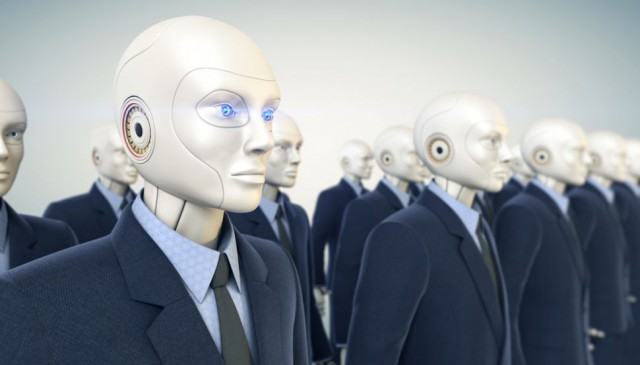Ghost in the Shell: How much can it get right?

The new Hollywood sci-fi blockbuster Ghost in the Shell imagines 2029, a world where cyber terrorists hack into people’s digitally enhanced minds and where cyborgs have crises of identity. So, how much has it got right? Is this the future?
Should we be concerned that our cybernetic development, already constantly on-boarding new connected technology, will reach a point where our brains become both infected and controlled by rabid self-willed robots? Well, probably not just yet. But the question is there -- should we countenance such a dystopian scenario? Of course we should.
Sci-fi writers have a remarkable track record when it comes to predicting the future. A decent volume about the (real) history of technology could be compiled from the wild imaginings of Star Trek alone. Its Communicator device, dating from 1964, pre-empted the mobile phone by a decade -- and its mass appeal by more than three. The Motorola Star Tac, the first flip-phone, was in fact an overt homage to the series.
Life imitates art, eventually. H. G. Wells described a society using "wrist intercoms" as far back as 1933 in The Shape of Things to Come, Dick Tracy’s two-way wrist radio first appeared in 1946 and Hergé, in an astonishing act of narrative lunar-cy, put Tintin on the moon in highly realistic detail more than a decade before Neil Armstrong took "one small step for mankind."
Geek rapture
And so, we have the latest Hollywood sci-fi blockbuster, Ghost in the Shell -- a re-make of the hugely popular 1990s Japanese anime series, itself taken from a manga comic -- which crosses-over contemporary narratives of cyber-hacking and artificial intelligence to imagine a logical end-point, where people’s minds can be infiltrated and controlled.
Its central theme, about the relationship between humans and machines, is already familiar to us from the likes of Philip K. Dick’s seminal Do Androids Dream of Electric Sheep? (reworked on screen as Blade Runner). Is this idea -- of humans and machines assuming processing power and emotional intelligence, from each other -- really so far fetched, now, to even qualify as science fiction?
The miniaturization of computing and the rise of wireless connectivity have, in the past two decades, only blurred the lines further between science fiction and science fact. Indeed, today’s technological realities are outrunning yesterday’s artistic inventions.
Cyberpunk novelist William Gibson, whose novel Neuromancer imagined humans augmented with computer implants, said a decade ago, before artificial intelligence was a part of the everyday dialogue, that the hockey stick of technological progress had already attained such a vertiginous incline that "geek rapture," where everything is possible, could arrive.
Neural lace
"We are all cyborgs now." So said UX designer and "cyborg anthropologist" Amber Case in a TED Talk of the same name, arguing that our use of technology already makes us cybernetic organisms. That was in 2010, as the promise of 3G waned before the LTE revolution and the rise in wearable gadgetry and the quantified self and way before such modish realities as the Internet of Things and artificial intelligence.
Hacking is so rarely out of the headlines that the central sci-fi concept of Ghost in the Shell doesn’t feel so far removed. Its essential ideas about artificial intelligence have entered the popular discourse, espoused by scientific thinkers and business people, not just by febrile artistic imaginations.
Last month, Elon Musk said humans will be required in the future to augment their own innate talents with machine intelligence if they are not to end up as "house cats" to robots. Similarly, Stephen Hawking said a few months back that the rise of artificial intelligence could go one of two ways: a reprieve for humankind, with a fairer society and a greener planet, or the decline of civilization, with willful automatons running amok.
We are playing for huge stakes, and not just for Hollywood plot lines. The idea of hacking a computer-enhanced brain is a serious thought provoker, which we should be considering. Musk’s address hinged on a new brain-machine interface, a "neural lace," to enable a kind of telepathy with machines; creating a company to pursue those ends.
Ethical questions
So how should we defend ourselves, if our brains are hacked? What if machines design and direct attacks, by themselves, on our IT networks and cybernetic systems just as a common thief snatches a bag? What prisons should we create for machines? Is the "death penalty" fair game, if a sentient robot strays? What if a machine we "care" about, in our electric dreams, is compromised by an attack, or faces trial?
These questions are at once controversial and ethically profound; but they will grow in urgency in the next decade. Just as regulatory bodies are starting to evaluate whether autonomous vehicles prioritize pedestrians or passengers, we must start to consider the rules that apply for the crossover of humans and machines.
As the Internet of Things evolves and becomes the Internet of Us, it seems as though humans will be the next target. In dystopian sci-fi visions of the future, there is an increasing number of humans being microchipped and made to carry out certain tasks, whether it’s running simple errands to committing serious crimes -- humans have no control. Despite this concept appearing slightly farfetched at this moment in time, the rapid advancement of technology brings with it a level of risk that will inevitably have wider implications -- not only for security and ethics but for our definition of humanity.
Let the debate begin -- and let it continue long after the movie hype has subsided, until we have conclusions, and can move with confidence down Hawking’s first path: towards a desperate, planetary reprieve.
David Jacoby, security evangelist at Kaspersky Lab
Image Credit: Tatiana Shepeleva / Shutterstock